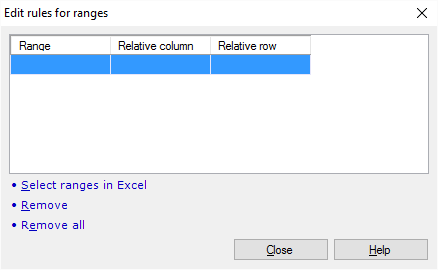Excel: Edit rules for ranges
When you import Excel workbooks in memoQ, you can import comments and the context with each source cell. The context and the comment is usually in a different cell.
In this window, you can set up rules that tell memoQ where the other cells are.
Use this window when you need to import several different ranges, and the comment or context cells are in a different place for each of them.
How to get here
- Start importing a legacy Excel workbook (an .xls or .xlt file).
- In the Document import options window, select the Excel workbooks, and click Change filter and configuration.
- The Document import settings window appears. From the Filter drop-down list, choose Microsoft Excel filter. The Microsoft Excel filter settings appear.
- Click the Comment and context options tab.
- Check the Import comments or the Import context IDs check box. Under the check box, click the Custom rules radio button.
- Next to the radio button, click Edit.
The Edit rules for ranges window appears.

What can you do?
Add a range and tell where the other cells are. The other cells contain the comment or the context for the cells in the original range. This depends on where you are coming from.
- To add a range: Click the Range field in the first empty row of the table.
- Type the reference to the range in the Excel format: sheetname!upper_left_cell:lower_right_cell (example: Sheet1!A1:B678). Press Tab.
If you don't know the letters and numbers for the range: Click Select ranges in Excel. memoQ opens the workbook in Excel, and opens the Mark selected ranges window. To do this, Microsoft Office Excel 2007 or higher must be installed on your computer.
- Click the Relative column field in the row you are filling in. Type a number that specifies how many columns away the other cells are.
- Click the Relative row field in the row you are filling in. Type a number that specifies how many rows away the other cells are.
- A negative number in Relative column means cells to the left of the imported cells. A positive number means cells to the right. Zero means the same column.
- A negative number in Relative row means cells above the imported cells. A positive number means cells below the imported cells. Zero means the same row.
Examples:
- To import cells from A1 through A100, and get the comment or the context from cells B1 through B100: Type 1 in C:, and 0 in R:.
- To import cells from A1 through Z1, and get the comment or the context from cells A2 through Z2: Type 0 in C:, and 1 in R:.
- To translate cells in column B, and get the comment or the context from column A: Type -1 in C:, and 0 in R:.
To remove one range from the list: Select it. Click Remove below the list.
To remove all ranges (to empty the list): Click Remove all below the list.
When you finish
To save the rules, and return to the Document import settings dialog: Click Close.
No way to cancel: Once you click Close, the rules will be saved. To remove them, open this window again, and click Remove All. Then click Close again.